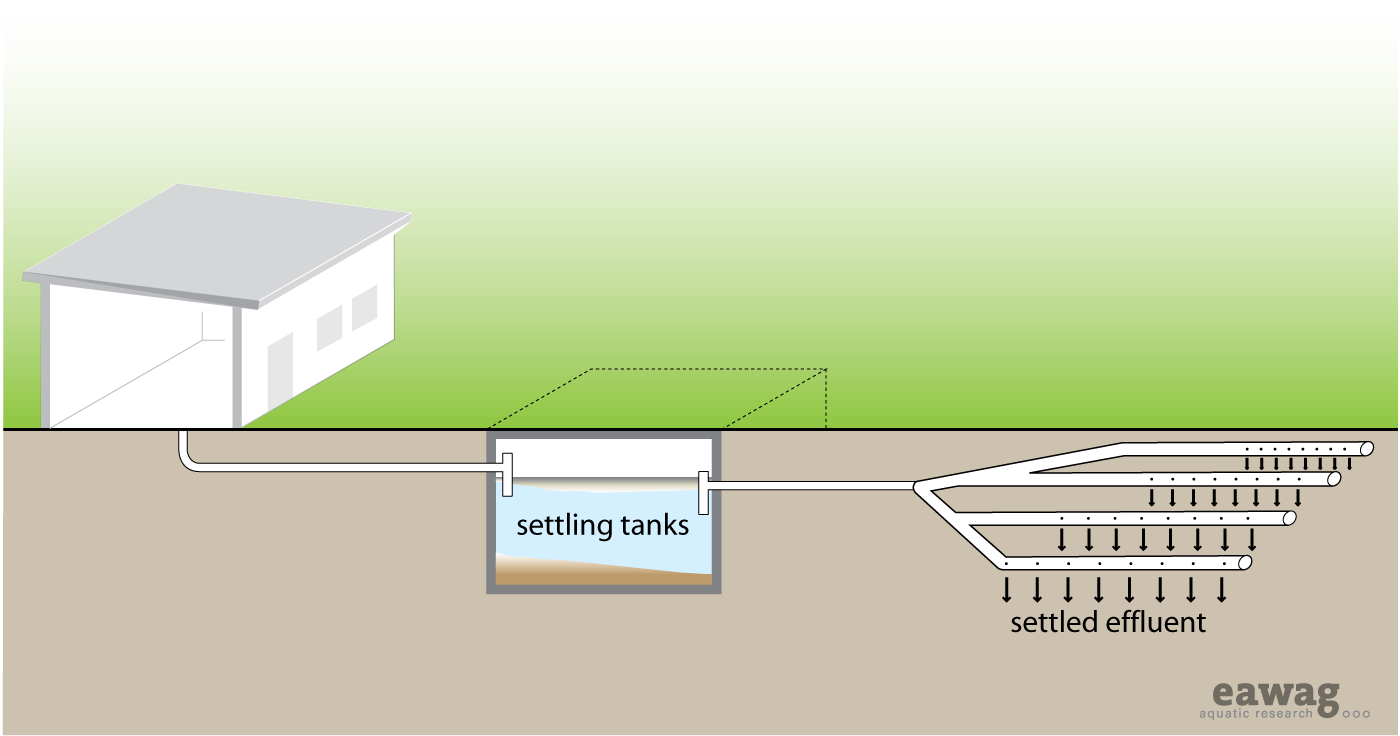Difference between revisions of "Leach Field"
| Line 11: | Line 11: | ||
sys7=| | sys7=| | ||
sys8=| | sys8=| | ||
| + | sys9=| | ||
pic=Leach_field.png| | pic=Leach_field.png| | ||
ApplHousehold=XX| | ApplHousehold=XX| | ||
Revision as of 03:38, 31 October 2014
|
|||||||||||||||||||||||||||
A Leach Field, or drainage field, is a network perforated pipes that are laid in underground gravel-filled trenches to dissipate the effluent froma water-based Collection and Storage/Treatment or (Semi-) Centralized Treatment technology.
Effluent is fed into a distribution box which directs the flow into several parallel channels. A small dosing system releases the pressurized effluent into the Leach Field on a timer (usually 3 to 4 times a day). This ensures that the whole length of the Leach Field is utilized and that aerobic conditions are allowed to recover between dosings. Each trench is 0.3 to 1.5m deep and 0.3 to 1m wide. The bottom of each trench is filled with about 15cm of clean rock and a perforated distribution pipe is laid overtop. More rock covers the pipe so that it is completely surrounded. The layer of rock is covered with a layer of geotextile fabric to prevent small particles from plugging the pipe. A final layer of sand and/or topsoil covers the fabric and fills the trench to the ground level. The pipe should be placed 15cm from the surface to prevent effluent from surfacing. The trenches should be dug no longer than 20m in length at least 1 to 2m apart.
| Advantages | Disadvantages/limitations |
|---|---|
| - Can be used for the combined treatment of blackwater and greywater. - Has a lifespan of 20 or more years (depending on conditions). - Low to moderate capital cost, low operating cost. |
- Requires expert design and construction. - Requires a large area (on a per person basis). - Not all parts and materials may be available locally. - Pretreatment is required to prevent clogging. - May negatively affect soil and groundwater properties. |
Contents
Adequacy
Leach Fields require a large area and soil with good absorptive capacity to effectively dissipate the effluent.
To prevent contamination, a Leach Field should be located 30m away from a drinking water supply. Leach fields are not appropriate for dense urban areas. They can be used in almost every temperature, although there may be problems with pooling effluent in areas where the ground freezes.
Homeowners who have a Leach Field must be aware of how it works and what their maintenance responsibilities are. Trees and deep-rooted plants should be kept away from the Leach Field as they can crack and disturb the tile bed.
Health Aspects/Acceptance
Since the technology is underground and it requires little attention, users will rarely come in contact with the effluent and so it should pose no health risk. The Leach Field must be kept as far away as possible from (>30m) any potential potable water sources to avoid contamination.
Upgrading
A Leach Field should be laid out such that it would not interfere with a future sewer connection. The collection technology which precedes the Leach Field (e.g. Septic Tank) should be equipped with a sewer connection so that if, or when, the Leach Field needs to be replaced, the changeover can be done with minimal disruption.
Maintenance
A Leach Field will become clogged over time, although with a well-functioning pre-treatment technology, this should take many years. Effectively, a Leach Field should require minimal maintenance, however if the system stops working efficiently, the pipes should be cleaned and/or removed and replaced. To maintain the Leach Field, there should be no plants or trees above it and no heavy traffic, which may crush the pipes or compact the soil.
References
- Crites, R. and Tchobanoglous, G. (1998). Small and Decentralized Wastewater Management Systems. WCB and McGraw-Hill, New York, USA. pp 905–927.
- Polprasert, C. and Rajput, VS. (1982). Environmental Sanitation Reviews: Septic Tank and Septic Systems. Environmental Sanitation Information Center, AIT, Bangkok, Thailand.
- USEPA (1980). Design manual- on-site wastewater treatment and disposal systems. EPA-625/1-80-012. Office of Research and Development, Municipal Environmental Research Laboratory, Cincinnati, Ohio.
Acknowledgements
The material on this page was adapted from:
Elizabeth Tilley, Lukas Ulrich, Christoph Lüthi, Philippe Reymond and Christian Zurbrügg (2014). Compendium of Sanitation Systems and Technologies, published by Sandec, the Department of Water and Sanitation in Developing Countries of Eawag, the Swiss Federal Institute of Aquatic Science and Technology, Dübendorf, Switzerland.
The 2nd edition publication is available in English. French and Spanish are yet to come.


